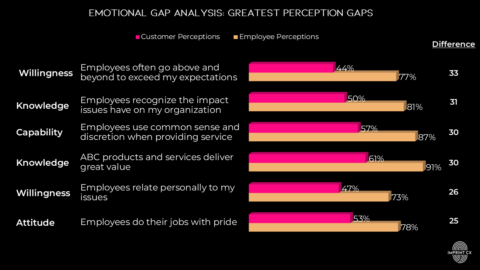Designing the best customer interactions is meaningless if there are emotional experience gaps between customers and employees.
To maximize customer lifetime value, businesses must understand the rational touchpoints, the emotional expectations, and any potential gaps.
An emotional experience gap occurs when there is a disconnect in how each group feels about the brand, the service, or the overall experience. While rational experience gaps focus on products, tools, and processes, the emotional gaps delve into perceptions, sentiment, and connection.
ImprintCX’s Emotional Gap Analysis (EGA) evaluates customer and employee perceptions across 20-25 customizable attitudinal statements within four key dimensions:
🔹Capabilities – Having the right tools and processes to help, versus feeling helpless
🔹Attitude – Being confident and helpful, versus arrogant and dismissive
🔹Willingness – Having brand passion and a desire to help, versus being indifferent
🔹Knowledge – Truly understanding customer needs and expectations, versus neglect
By analyzing the gaps between employee and customer perceptions across these dimensions, we uncover what’s missing in the experience—and how to fix it.
Why It Matters:
✅ Customers can sense when employees are disengaged, affecting not only your brand perception but also profitability.
✅ Employees who experience misalignment are more likely to feel frustrated, burned out, and disengaged, making it harder to deliver authentic and meaningful interactions.
✅ Closing these gaps requires more than just training—it demands a work environment where employees feel empowered, valued, and emotionally invested in their roles.
These gaps directly impact customer satisfaction, loyalty, and business success.
💡 How does your organization ensure employees and customers are emotionally aligned?
Want to learn more about ImprintCX’s Emotional Gap Analysis – let’s talk